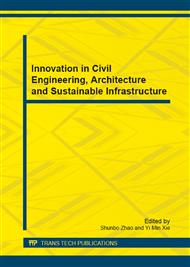p.694
p.697
p.701
p.705
p.709
p.714
p.719
p.723
p.728
Study on Construction Process of Suspension Bridge Based on a Co-Rotational Framework
Abstract:
Based on a co-rational (CR) framework, a 2-noded element formulation of 3D truss was presented, which was used for accurately modeling of suspension bridges with large displacements and rotations. The CR framework could consider the out-plane stiffness by the geometric stiffness, which was applicable to the analysis of 3D cable bridges. Using the co-rational truss united with the energy convergence criteria and the Newton with Line Search Algorithm, the nonlinear behavior of 3D cable structural system was simulated conveniently and accurately. Therefore, the traditional truss elements based on elastic modulus modified method and complex catenary elements were avoided. In order to simulate the hanging of girder and the structural system changing during the construction, the elements’ killing and activating methods were realized by the modulus modified methods.
Info:
Periodical:
Pages:
709-713
Citation:
Online since:
November 2012
Authors:
Keywords:
Price:
Сopyright:
© 2012 Trans Tech Publications Ltd. All Rights Reserved
Share:
Citation:


